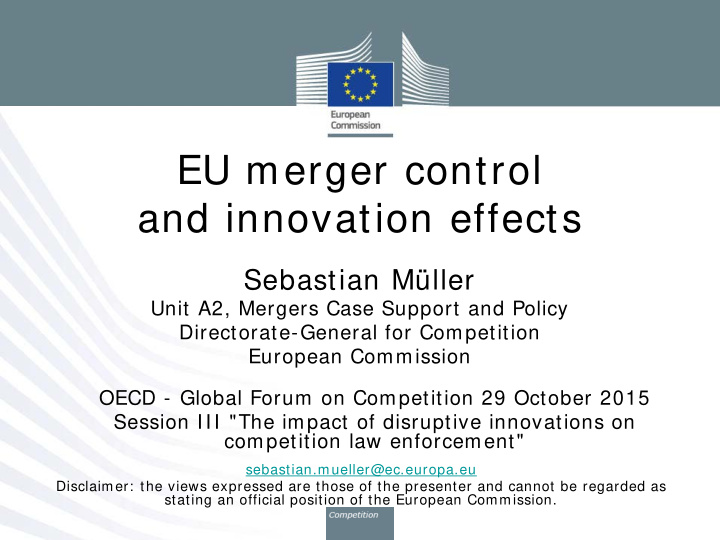



EU merger control and innovation effects Sebastian Müller Unit A2, Mergers Case Support and Policy Directorate-General for Competition European Commission OECD - Global Forum on Competition 29 October 2015 Session III "The impact of disruptive innovations on competition law enforcement" sebastian.mueller@ec.europa.eu Disclaimer: the views expressed are those of the presenter and cannot be regarded as stating an official position of the European Commission.
EU legal framework to assess negative innovation effects • Protect competition not only to ensure lower prices or increased output, but also product quality, variety and innovation important competitive dimension • Assess innovation potential of merging firms regardless of their current market positions • For potential competition: • (i) Show significant competitive constraint exerted by potential competitor or likelihood it would become an effective competitive force • (ii) Absence of sufficient number of other potential competitors
Horizontal mergers • Merger can lead to loss of innovation by eliminating innovative (pipeline) products • Concerns remedied in number of pharmaceutical and medical devices mergers regarding pipeline products (late-stage clinical trials) • In Novartis/ GloaxoSmithKline’s oncology business , Commission found merger to reduce innovation as Novartis would likely abandon early-stage clinical trials for treating certain cancers • Remedy: Novartis divests drug and commits to co- fund development of existing and new clinical studies
Non-horizontal mergers • Harm to ability of merged entity’s rivals to innovate • Intel/ McAfee : combination of chips and security software • Remedy: • Preserves beneficial effects of merger (allowing for combination of chips with security software) • But ensures that Intel cannot block other security software providers from accessing its chips and interoperability information Allows third parties to innovate on Intel platform
Positive innovation effects: efficiencies • Positive innovation effects assessed as efficiencies. Must be (i) likely to be passed-on to consumers, (ii) verifiable, and (iii) merger-specific • In TomTom/ TeleAtlas , innovation efficiencies acknowledged as at least partly merger-specific and beneficial to consumers (improve quality and timing of TeleAtlas map creation by using TomTom’s users’ GPS information) • No definitive conclusion as to verifiability
Conclusion • EU legal framework for merger control explicitly addresses a merger’s positive and/ or negative effects on innovation • Remedies to address: • Loss of innovation may involve divestiture of (pipeline) products • Harm to third parties’ ability to innovate may also involve access remedies or other non-divestiture remedies • For more detail as well as additional case studies, see contribution by the European Commission DAF/ COMP/ GF/ WD(2015)39 of 15 October 2015
Recommend
More recommend